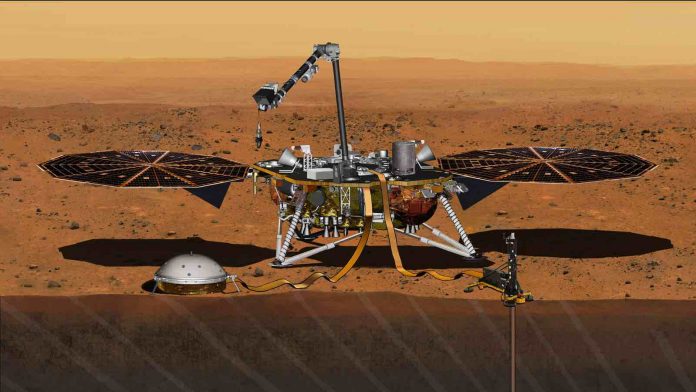NASA has begun the final preparations for its next – and most ambitious – rover landing on Mars.
The InSight probe blasted off on May 5th, and, NASA hopes, will touch down on the Martian surface on November 26th.
If it manages to land on the red planet, it will drill down into the surface of Mars in a groundbreaking study that could reveal how the red planet – and earth – formed.
InSight will study the deep interior of Mars, taking the planet’s vital signs, its pulse and temperature, and NASA says it will ‘give Mars a thorough checkup for the first time since the planet formed 4.5 billion years ago.
‘InSight will teach us about the interior of planets like our own.
‘The mission team hopes that by studying the deep interior of Mars, we can learn how other rocky worlds, including Earth and the Moon, formed.’
A slender cylindrical probe dubbed the mole is designed to tunnel nearly 16 feet (five metres) into the Martian soil.
A quake-measuring seismometer, meanwhile, will be removed from the lander by a mechanical arm and placed directly on the surface for better vibration monitoring.
Previous missions to the Red Planet have investigated its surface by studying its canyons, volcanoes, rocks and soil.
But the signatures of the planet’s formation can only be found by sensing and studying its vital signs far below the surface.
However, beforethe InSight lander can begin its job on Mars, it will have to survive a treacherous re-entry and landing through the planet’s atmosphere.
After travelling over 300 million miles in space and reaching the martian atmosphere, the InSight spacecraft only has seven minutes to land safely on the surface — often referred to as the most treacherous stage of the mission, according to the agency.
‘Landing on Mars is hard, and this mission in no different,’ said Rob Manning, chief engineer at NASA’s Jet Propulsion Laboratory,
‘It takes thousands of steps to go from the atmosphere to the surface, and each has to work perfectly.’
The craft will reach up to 13,000 miles per hour as it descends through the atmosphere.
InSight is scheduled to land on a flat, smooth plain close to the planet’s equator known as the Elysium Planitia.
‘Where we land is an intentionally dull place,’ Neil Bowles, a UK researcher involved in the mission, told the Guardian.
‘It’s flat, empty and hopefully not very windy. And that is precisely what we need’.
The success rate of landing on Mars, counting orbiters and landers by Nasa and others, is only about 40 per cent.
If the lander survives its landing, the solar-powered InSight will spend two Earth years – about one Martian year – plumbing the depths of the planet’s interior for clues to how Mars took form and, by extension, the origins of the Earth and other rocky planets.
While Earth’s tectonics and other forces have erased most evidence of its early history, much of Mars – about one-third the size of Earth – is believed to have remained relatively static for more than 3 billion years, creating a geologic time machine for scientists.
‘The science we want to do with this mission is really the science of understanding the early solar system,’ Bruce Banerdt, InSight principal investigator said during an interview ahead of the launch of the craft.








